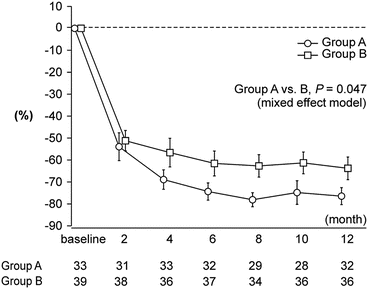Fig. 19.1
Trial profile
The two groups did not differ in age, gender distribution, eGFR, urinary protein excretion, blood pressure, the proportion of patients’ given renin-angiotensin system (RAS) inhibitors, and histological grades (Table 19.1).
Table 19.1
Baseline patient characteristics
Group A | Group B | |
|---|---|---|
Tonsillectomy/steroid pulse therapy | Steroid pulse therapy alone | |
(n = 33) | (n = 39) | |
Age (years) | 36 (13) | 40 (13) |
Gender | ||
Male | 17* (52) | 18* (46) |
Female | 16* (48) | 21* (54) |
eGFR (ml/min/1‧73 m2) | 75 (24) | 69 (22) |
Proteinuria (g/day) | 1.6 (0.5) | 1.6 (0.6) |
Proteinuria (g/g creatinine) | 1.7 (1.0) | 1.7 (1.0) |
Systolic blood pressure (mmHg) | 117 (12) | 121 (10) |
Diastolic blood pressure (mmHg) | 69 (9) | 73 (8) |
Mean arterial pressure (mmHg) | 85 (9) | 89 (8) |
Patients receiving RAS-I (%) | 16* (48) | 18* (46) |
Histological grade | ||
Good prognosis | 0* | 0* |
Relatively good prognosis | 2* (6) | 3* (8) |
Relatively poor prognosis | 20* (61) | 23* (59) |
Poor prognosis | 11* (33) | 13* (33) |
19.2.2.1 Impact of Steroid Pulses and Tonsillectomy on Proteinuria
Figure 19.2 shows the percent changes in urinary protein excretion from baseline during the trial period. As revealed by a mixed effect model employing six fixed effects (group allocation, eGFR, mean arterial pressure, the use of RAS-I at baseline, time, and the interaction of group and time), the percentage decrease in urinary protein excretion during the 12 months from baseline was significantly larger in Group A than that in Group B (coefficient estimate −1.316, 95 % CI −2.617 to −0.015, P = 0.047). The percentage of patients with the disappearance of proteinuria (<0.3 g/gCr) was significantly higher in Group A than in Group B after 10 months (P = 0.029; Fig. 19.2). However, at 12 months, the difference was not statistically significant (Group A, 63 %; Group B, 39 %; P = 0.052).


Fig. 19.2
Urinary protein excretion during the trial period. Mean values and standard errors are presented
19.2.2.2 Impact of Steroid Pulses and Tonsillectomy on Hematuria
The severity of microscopic hematuria gradually decreased following the initiation of therapy in both groups. However, the proportion of patients with the disappearance of hematuria was not different between the two groups at any time point (e.g., at 12 months, Group A, 68 %; Group B, 64 %, P = 0.672).
19.2.2.3 Impact of Steroid Pulses and Tonsillectomy on Clinical Remission
The disappearance of both proteinuria and hematuria (i.e., clinical remission) did not occur at a higher rate in Group A than in Group B at any time point (P = 0.160 at 10 months, P = 0.103 at 12 months).
19.2.2.4 Impact of Steroid Pulses and Tonsillectomy on Renal Function
eGFR remained stable throughout the trial period and was comparable between the two groups at 12 months (Group A, 75 mL/min/1.73 m2; Group B, 69 mL/min/1.73 m2). No patient in either group showed a 100 % increase in serum creatinine from baseline or a 50 % decrease in eGFR from baseline or had indications for renal replacement therapy.
No adverse effect related to tonsillectomy or general anesthesia was reported. One patient in Group A and three in Group B developed diabetes during the trial period, with one of these Group B patients requiring insulin therapy during the treatment with corticosteroid. At the end of the study, blood sugar levels of all four patients were restored to the normal range.
19.2.2.5 Logistic Regression Analysis
Logistic regression analysis was performed to evaluate the impact of multiple covariates on the disappearance of proteinuria or hematuria and the occurrence of clinical remission. Independent variables included the allocated treatment, eGFR, mean blood pressure, urinary protein excretion, and the use of RAS-I at baseline (Table 19.2). Only the allocated treatment had a significant and independent impact on the disappearance of proteinuria (hazard ratio, 2.98; 95 % confidence interval, 1.01–8.83; P = 0.049). No independent factors were identified as achieving the disappearance of hematuria or clinical remission.
Table 19.2
Logistic regression analysis of the impact of tonsillectomy, renal function, blood pressure, and urinary protein excretion at baseline and after disappearance of proteinuria, hematuria, or both at study completion
Odds ratio | 95 % CI | P value | |
|---|---|---|---|
Disappearance of proteinuria | |||
Assigned treatment | 2.98 | 1.01–8.83 | 0.049 |
eGFR (baseline) | 0.99 | 0.97–1.02 | 0.560 |
Mean blood pressure (baseline) | 1.04 | 0.97–1.11 | 0.297 |
Proteinuria (baseline) | 0.61 | 0.33–1.13 | 0.115 |
RAS-I (baseline) | 0.51 | 0.16–1.68 | 0.270 |
Disappearance of hematuria | |||
Assigned treatment < div class='tao-gold-member'>
Only gold members can continue reading. Log In or Register to continue
Stay updated, free articles. Join our Telegram channel
Full access? Get Clinical Tree
 Get Clinical Tree app for offline access
Get Clinical Tree app for offline access

| |||




